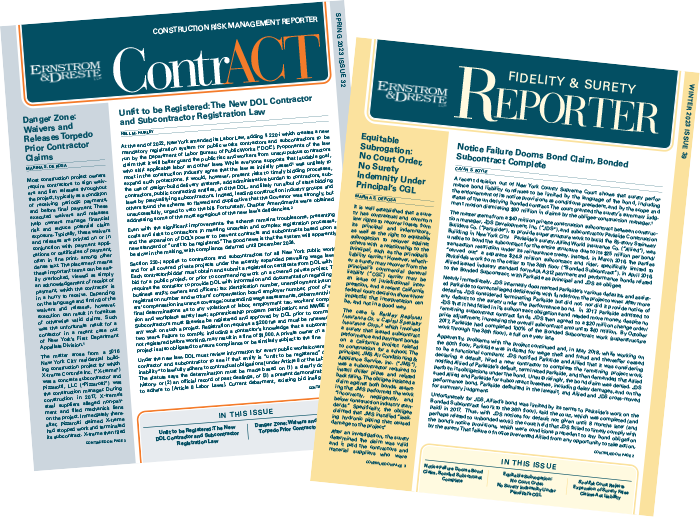Article by: Cavan S. Boyle
Fundamental to all litigation is the disclosure of information through the discovery process. So, too, is the mastery of strategies for protection of privileged material from such disclosure. In the surety context, certain privilege claims are common. For example, where the surety and principal work together against an obligee to pursue or defend a claim, it can give rise to a common interest/joint defense privilege. Likewise, the customary involvement of consultants adds to the privilege picture, both in their role in the investigation of claims, and as experts. A recent performance bond case out of the Southern District of New York emphasizes the significant burden faced to successfully assert these privileges.1
In Higgins v. Dobco, the principal (“Higgins”) and its surety sought guidance for privilege protection of their communications, the investigative files generated by the surety during its bond claim investigation, and communications between Higgins and the surety with various consultants. The decision is a reminder of the potential privilege pitfalls inherent in the claims investigation process.
Common Interest Doctrine: Communications among different parties, and with other parties’ attorneys, are ordinarily subject to discovery. However, where the parties have undertaken a “joint defense effort” in furtherance of common legal strategies, they can be protected under the common interest doctrine, an extension of the attorney-client privilege.
Higgins and the surety sought to shield all their communications under the common interest doctrine. The court explained that there is no such blanket application, noting that the issue must be determined based upon a fact-specific analysis, with the party seeking protection bearing the burden to demonstrate the doctrine applies. “[T]he common interest privilege,” the court said, “does not transform an otherwise non-privileged communication…into a protected one simply because it was exchanged between a principal and its surety.”2 Among other things, the court required detailed information as to how and when the common interest arose and to which specific communications the doctrine applies.
Work-Product Doctrine: To determine whether the surety’s files from its performance bond claim investigation are privileged, the Higgins court analogized the work-product doctrine applicable to sureties to that applicable to insurers. Both have a duty to investigate claims and can deny liability, reasoned the court, and documents created after that denial are more likely to be work product prepared in anticipation of litigation. Nonetheless, the court required additional information for fact-specific determinations, with a focus on the timing of the default notice and claim denial, and the purpose of each file for which privilege is asserted.
Consulting Expert Privilege: Higgins and the surety also sought protection from disclosure for all communications they had with “consultant experts.” The court noted that the rule protecting non-testifying expert disclosure is designed to allow litigants to consult experts for claim evaluation without fear of disclosing this information later, but cautioned that the rule will not “conceal communications with professionals engaged in the ordinary course of business by transforming them into non-testifying experts.” In other words, protection typically depends on the purpose of the retention of the consultant and the work performed – was it “ordinary course of business” work or was it done “in anticipation of litigation” for the purpose of furthering a legal strategy? The court directed the parties to provide additional information, this time focusing on when, by whom, and for what purpose the experts were retained.
The Higgins court did not render a result on these privilege issues but made this essential point: facts detailing the timing, nature, and purpose of alleged privileged communications are paramount. With that in mind, from the very outset of a claim situation, the surety should strive to document its files in a way that protects against the inadvertent disclosure of confidential information, including following document protocols. Whenever a consultant (or attorney, for that matter) is retained, the scope and purpose of its work should be clearly defined, especially planned use for legal guidance or claim analysis in preparation for anticipated litigation. Timing of retention will likely factor heavily for consultants, as the surety is in the business of investigating claims. But be advised that “ordinary course of business” communications and reports will not be privileged, regardless of who prepares them or when. Labeling can help identify potentially privileged information (“prepared in anticipation of litigation”), but a court will still look to the facts.3 Regardless of the surety’s protective measures, however, the surety should expect that most of its investigative files will be discoverable.
Similarly, where a surety and principal determine that they share a common interest in a legal matter, in most circumstances a written joint defense agreement should be prepared early on. This will permit the surety (and the principal) to better protect otherwise discoverable, sensitive information from disclosure.
- U.S. ex rel. M. Frank Higgins & Co. v. Dobco Inc., 2023 WL 5302371 (S.D.N.Y. Aug. 17, 2023).
- It is assumed that there was also some manner of attorney involvement or else the doctrine would not be applicable.
- This is also true for attorney-client privilege, where copying outside counsel does not necessarily make the document privileged.




